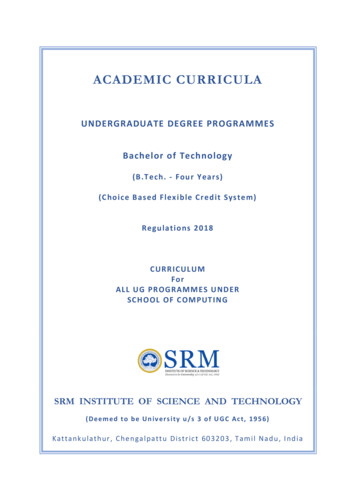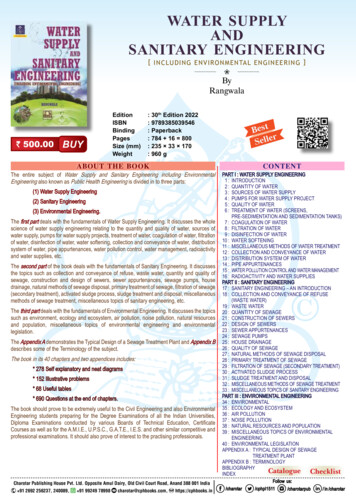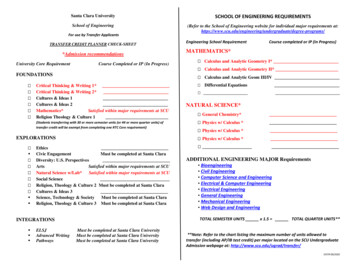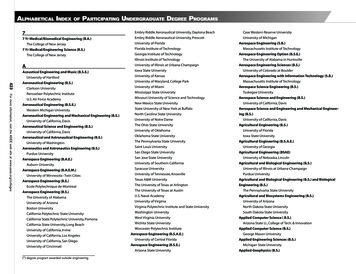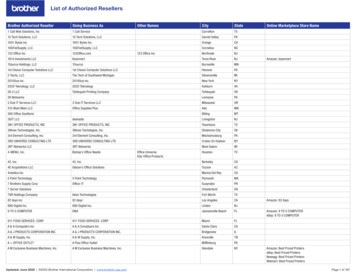
Transcription
[Gomes, 6(6): June 2019]DOI- 10.5281/zenodo.3249484ISSN 2348 – 8034Impact Factor- 5.070GLOBAL JOURNAL OF ENGINEERING SCIENCE AND RESEARCHESSTUDY AND MONITORING OF IONIZING RADIATIONS USING GEIGER RUSSIANTUBE AND ARDUINO ELECTRONIC SYSTEM IN THE REGION OF SÃO JOSÉ DOSCAMPOS, BRAZIL*1,3Rafael Augusto Gomes*1, Rodrigo Rezende F. de Carvalho2 & InácioMalmonge Martin³Department of Physics, Technological Institute of Aeronautics ITA São José dos Campos, São Paulo,BrazilABSTRACTThe ionizing radiation is mainly the result of radon gas, the telluric radiation and the primary and secondary cosmicradiation produced at the interface of the ground level and the low atmosphere. However, it is difficult to separateover time the intensity of the ionizing radiation from each component as the energies overlap. The telluric radiationconsists of decay products of 238 U, 235 U, 40 K, and 232 Th which is constant in each specific region. During the periodof 11/06/2018 to 02/28/2019 it was possible to measure the intensity of the ionizing radiation every minute, with theaid of a simple system developed in the Physics Department of the Technological Institute of Aeronautics (ITA),composed of a Russian Geiger and Arduino electronic system.Keywords: Ionizing Radiation, Russian tube Geiger, telluric and cosmic radiation.I.INTRODUCTIONLow energy ionizing radiation (α, β, X and gamma rays) in the local environment depends on the presence ofradionuclides and radon gas around the region. Ionizing radiations with energy above 12eV (E 12 eV) can pullelectrons from an atom in the environment where they move. Its geological origin is largely the result of the decayof radioactive isotopes of potassium (40 K), uranium (238 U) and thorium (232 Th). During radioactive decay, the nucleican emit alpha, beta, gamma or X-ray radiation. Moreover, natural radioactive isotopes belonging to each decayseries mentioned above are formed. The 235 U has a half-life of 713 million years, while the 238U has a half-life of 4.5billion years. Thereby, there is in environment a smaller amount of 235 U comparing to 238 U.The other major source of ionizing radiation at the soil / air interface is the radon gas ( 222 Rn), which is also formedby the decay of uranium and thorium. The radioactive decay of radon produces 218Po, 214Pb and 214Bi, and theseisotopes can be observed in the air near the ground by the presence of alpha, X and gamma particles. An importantfact related to radon is that during rainfall, the concentration close to the ground may increase due to the transport ofthis gas by raindrops.The radiation of the cosmic component (primary and secondary) produced in the lower atmosphere varies little overtime. However, it varies greatly with latitude and height above the Earth's surface. This cosmic radiation produces"extensive air showers" composed of particles and photons of energy that reach the surface of the Earth. Artificialionizing radiations are those produced by humans in a variety of activities such as medicine, dentistry and researchin industry. However, radiation sources are, in principle, confined and under control at a specific location.II.METHOD & MATERIALA simple system was developed for the detection of ionizing radiation where a Geiger is used with Russian tube 16centimeters long by 2 centimeter diameter with internal pressure of 3 atmospheres, both subject to voltage of 500VDC, together with the Arduino electronics, a scale-type pluviometer rain gauge was used to measure daily rainfallin mm / min. Then the measurements of the ionizing radiation initiated on 09/09/2018 until 02/28/2019 are beingcarried out.118(C)Global Journal Of Engineering Science And Researches
[Gomes, 6(6): June 2019]DOI- 10.5281/zenodo.3249484ISSN 2348 – 8034Impact Factor- 5.070The monitors are being performed by means of ionizing radiation counts per minute. With the data obtained fromthe monitors, graphs are generated where the analysis is done through the software Excel and Origin 1.5, and canthen monitor the intensity of the ionizing radiation at the soil / air interface.Figure 01:View of the RussianGeiger Ceramic Tube with the arduino systemIII.RESULT & DISCUSSIONIonizing radiation was monitored at the soil / air interface during the period from November 6, 2018 to February 28,2019, where the count of the Geiger Russian tube was analyzed every minute. It is observed when analyzing thegraphs that the Geiger Russian tube manages very well to measure the variations night / day of the period withoutrains. The "smooth" in green represents the variation of the intensity of the radiation per day.The figure 2 belowshows the result of the entire analyzed period.Figure 02:Monitoring the Russian Geiger tube count per minute during the day 11/06/2018 to 02/28/2019. The green line correspondingto 1 day smoothed curveFigure 3 shows the measurements in the period from November 6, 2018 to November 30, 2018. Periods of droughtcan be observed between 5000 and 15000 minutes, representing the high variation of the intensity of the ionizing119(C)Global Journal Of Engineering Science And Researches
[Gomes, 6(6): June 2019]DOI- 10.5281/zenodo.3249484ISSN 2348 – 8034Impact Factor- 5.070radiation. Then between the periods of 25000 to 35000 there was much rain and the low variation of the radiationcould be noticed. The correlation between the climate and the intensity of the radiation can be seen in figure 3.Figure 03:Monitoringthe Geiger Russian tube count per minute correlated with rainfall during the day period 11/06/2018 to 11/30/2018.The green line corresponding to 1 day smoothed curveThe figure 4 shows the monitoring results for the month of December of the year 2018.120(C)Global Journal Of Engineering Science And Researches
[Gomes, 6(6): June 2019]DOI- 10.5281/zenodo.3249484ISSN 2348 – 8034Impact Factor- 5.070Figure 04:Monitoring the Geiger Russian tube count per minute during the day 12/01/2018 to 12/31/2018.The green line correspondingto 1 day smoothed curve.Figure 05 shows the monitored results inJanuary of the year 2019Figure 05:Monitoring the Geiger Russian tube count per minute during the day 01/01/2019 to 01/31/2019. The green line correspondingto 1 day smoothed curve.Figure 06 shows the monitored results inFebruary of the year 2019.121(C)Global Journal Of Engineering Science And Researches
[Gomes, 6(6): June 2019]DOI- 10.5281/zenodo.3249484ISSN 2348 – 8034Impact Factor- 5.070Figure 06:Monitoring the Geiger Russian tube count per minute during the day 02/01/2019 to 02/28/2019. The green line correspondingto 1 day smoothed curve.With the aid of the system mounted and used to monitor the intensity of the ionizing radiation at the soil / airinterface, it was also possible to monitor the relative humidity and atmospheric pressure.Figure 7 shows the monitoring of atmospheric pressure every minute during the period from November 6, 2018 toFebruary 28, 2019.Figure 07:Monitoring of atmospheric pressure every minute during the period from 06 November 2018 to 28 February 2019Figure 8 shows the average relative humidity variation at each minute during the period from November 06, 2018 toFebruary 28, 2019122(C)Global Journal Of Engineering Science And Researches
[Gomes, 6(6): June 2019]DOI- 10.5281/zenodo.3249484ISSN 2348 – 8034Impact Factor- 5.070Figure 08:Relative humidity monitoring per minute during the period from 06 November 2018 to 28 February 2019IV.CONCLUSIONA simple system was developed, consisting of a Geiger with Russian pipe along with the associated Arduinoelectronics where it is possible to acquire data from minute to minute and can perform environmental radiationmonitors. Soon this facilitates the verification of atmospheric phenomena and their variations in time. It was alsopossible to verify that during the dry season the exhalation of radon gas emits gamma radiation and alpha particles inthe region. As a conclusion, the intensity of ionizing radiation and rainfall in mm / min, in the region, was measuredby a simple and very low cost process with interest for teaching and research.V.ACKNOWLEDGEMENTSThanks to CNPq (National Counsel of Technological and Scientific Development) and CAPES (Coordination forthe Improvement of Higher Education Personnel) by the fellowships grants support to the group’s researchers andthe ITA Division of Fundamental Sciences for supporting this research. Thanks also to INCT-FNA-ITA to supportthis research at ITA.REFERENCES1.2.3.4.5.Bui, Van, N. A., Martin, I. M., and Júnior, A. T. 1988. “Measurements of Natural Radioactivity at DifferentAtmospheric Depths.” Geophysics Magazine 28 (July): 262-266.Martin, I. M. 1982. “Measurements of Natural Radioactivity.” Report, Science and Culture Magazine (May):1065-1069.Lima, A. A. M. 2007. “Radiation in Basic and Secondary Education.” Master thesis, University of Coimbra.Martin, I. M., Alves, M. A., Júnior, M. A. A., andAlves, T. E. 2011. “Measurement of Dose Ionizing Radiationin the Period from 2008 to 2011 in São José Dos Campos, SP. Brail.” In 63thAnnual Meeting of the BrazilianSociety for Science Progress, 5247-47.Tsukuda, T. 2008. “Radon-Gas Monitoring by Gamma-Ray Measurements on the Ground for DetectingCrustal Activity Changes.”Bull. Earth. Res. Inst.2: 227-241.123(C)Global Journal Of Engineering Science And Researches
[Gomes, 6(6): June 2019]DOI- 10.5281/zenodo.32494846.7.8.9.ISSN 2348 – 8034Impact Factor- 5.070Fujinami,N. 2009. “Study of Radon Progeny Distribution and Radiation Dose Rate in the Atmosphere.”JapanJournal Health Physics 44 (1): 88-94.Martin, I. M. 1974. “Gamma Radiation in Atmosphere.” Ph.D. thesis, University De Toulouse III-PaulSabatier., França.Martin, I. M. 1971. “Variation of the Neutron Flux and Gamma Rays of Origin Cosmic as a Function ofLatitude.” Master thesis, University de Toulouse III-Paul Sabatier.Grieder, P. K. F. (2010). Extensive Air Showers.SpringerVerlag. Book.124(C)Global Journal Of Engineering Science And Researches
STUDY AND MONITORING OF IONIZING RADIATIONS USING GEIGER RUSSIAN TUBE AND ARDUINO ELECTRONIC SYSTEM IN THE REGION OF SÃO JOSÉ DOS CAMPOS, BRAZIL Rafael Augusto Gomes*1, Rodrigo Rezende F. de Carvalho2 & InácioMalmonge Martin³ *1,3 Department of Physics, Technological Institute of Aeronautics ITA São José dos Campos, São Paulo, Brazil .




